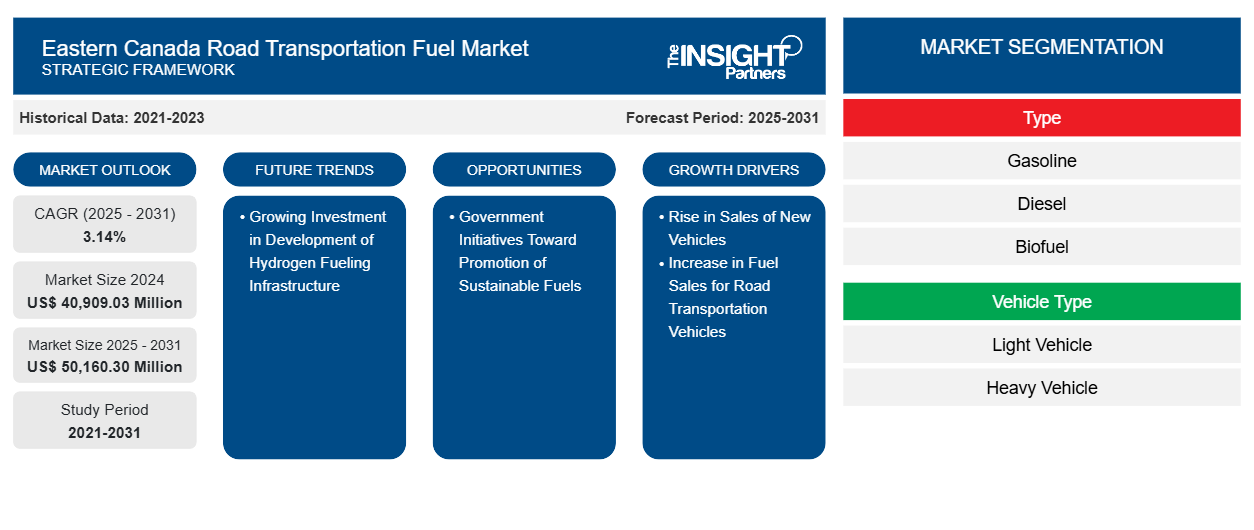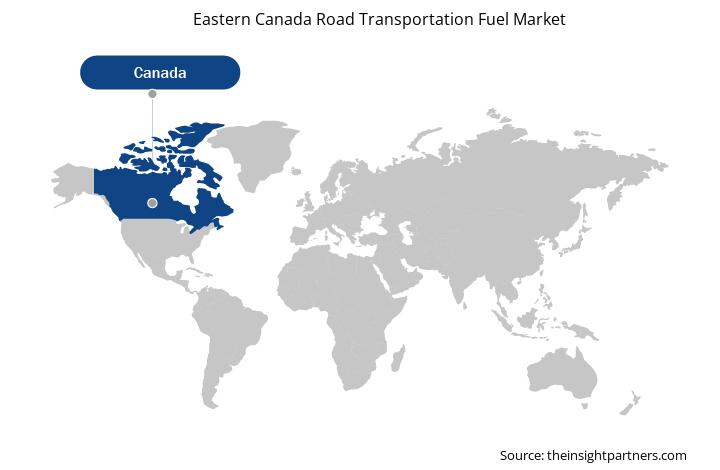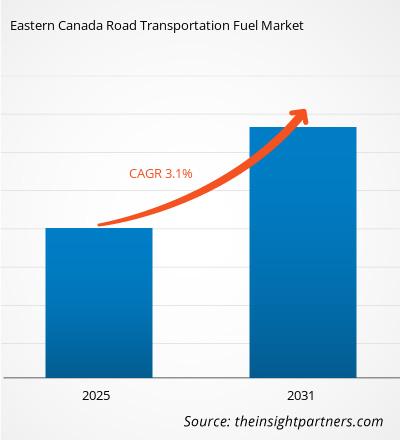동부 캐나다 도로 운송 연료 시장 규모는 2024년 409억 903만 달러에서 2031년 501억 6,030만 달러로 성장할 것으로 예상됩니다. 2025년부터 2031년까지 연평균 성장률(CAGR)은 3.14%에 이를 것으로 예상됩니다. 운송 산업에 대한 투자 증가는 향후 몇 년간 시장에 새로운 트렌드를 가져올 것으로 예상됩니다.
동부 캐나다 도로 운송 연료 시장 분석
운송 연료는 캐나다 경제에서 중요한 역할을 합니다. 동부 캐나다 운송 연료 시장 생태계의 주요 이해관계자는 정유소, 운송 연료 유통업체 및 소매업체, 그리고 최종 사용자입니다. 주요 최종 사용자에는 여객 및 화물 운송 차량이 포함됩니다. 도로 운송은 상품 운송과 사람 운송으로 구분됩니다. 운송 연료는 다양한 운송 수단에 사용되는 내연 기관에 동력을 공급하는 에너지원입니다. 운송 부문에는 사람과 상품의 이동에 사용되는 도로(자동차, 트럭, 버스 포함), 철도, 해상, 항공 운송이 포함됩니다. 운송 부문은 에너지 소비의 약 20%를 차지하며 캐나다에서 가장 큰 석유 소비국입니다. 운송 연료는 추출된 에너지 자원을 사용 가능한 제품으로 전환하는 정제 공정의 결과물입니다. 액체 연료는 주요 연료원의 화학적 특성에 따라 달라집니다. 현재 운송 연료의 80% 이상이 석유에서 유래합니다. 온타리오주와 퀘벡주는 도로 운송 연료 소비자가 많기 때문에 동부 캐나다의 도로 운송 연료 시장에 상당한 영향을 미칩니다.
동부 캐나다 도로 운송 연료 시장 개요
캐나다 자동차 생산 및 판매 증가는 도로 운송용 연료 시장 성장을 견인합니다. 또한, 도로 운송 차량용 연료 판매 증가는 캐나다 동부 도로 운송 시장 성장을 촉진합니다. 더욱이, 도로 운송 분야에서 지속 가능한 연료 사용을 장려하는 정부 정책은 2025년부터 2031년까지 시장 성장을 촉진할 것으로 예상됩니다. 나아가, 수소 연료 인프라 개발에 대한 투자 증가는 예측 기간 동안 시장의 주요 트렌드가 될 것으로 전망됩니다.
동부 캐나다 도로 운송용 연료 시장을 주도하는 주요 산업 으로는 운송 및 물류, 건설, 광업, 석유 및 가스, 의료, 전자상거래 등이 있습니다 . 캐나다 연료 협회에 따르면, 매년 약 2억 리터의 연료가 캐나다 전역의 차량 연료 탱크에 주입됩니다. 캐나다에는 16개의 정유소, 75개의 연료 유통 터미널, 그리고 12,000개 이상의 소매 및 상업 시설이 있습니다. 또한, 캐나다 정부는 주 정부와 협력하여 캐나다의 미래 연료 믹스 및 에너지 전환 목표 달성을 위해 대체 연료 또는 지속 가능한 연료를 장려하고 있습니다. 캐나다 소비자들의 대형 차량 선호도 증가는 휘발유와 경유 수요에 상당한 영향을 미치며, 이는 결국 캐나다 시장 성장을 견인할 것으로 예상됩니다.
동부 캐나다 도로 운송용 연료 시장의 최종 사용자는 경차와 중차입니다. 이러한 차량은 전국의 여객 및 화물 운송에 사용됩니다. 이 지역의 신규 차량 등록 증가는 향후 몇 년간 도로 운송용 연료 수요를 견인할 것으로 예상됩니다. 물류, 전자상거래, 제조 및 건설 부문의 성장에 힘입어 동부 캐나다의 도로 운송을 통한 무역 활동 증가는 2025년부터 2031년까지 도로 운송용 연료 수요를 증가시킬 것으로 예상됩니다.
이 보고서의 일부 또는 국가 수준 분석, Excel 데이터 팩을 포함하여 모든 보고서에 대한 사용자 정의를 무료로 받을 수 있으며, 신생 기업 및 대학을 위한 훌륭한 혜택과 할인도 이용할 수 있습니다.
동부 캐나다 도로 운송 연료 시장: 전략적 통찰력

-
이 보고서에서 주요 시장 동향을 알아보세요.이 무료 샘플에는 시장 동향부터 추정치 및 예측까지 다양한 데이터 분석이 포함됩니다.
동부 캐나다 도로 운송 연료 시장 동인 및 기회
도로 운송 차량 연료 판매 증가
최근 몇 년 동안 캐나다는 트럭 운송 연료 판매량이 크게 증가했습니다. 이러한 증가는 경제 상황과 소비자 선호도 변화를 반영하는 다양한 요인에 기인합니다. 이는 경제에서 중요한 역할을 하는 캐나다 교통 부문의 전반적인 역학 관계를 보여줍니다. 캐나다가 코로나19 팬데믹의 여파에서 회복세를 보이면서 경제 활동이 눈에 띄게 증가하여 연료 수요가 증가했습니다. 사업 활동 재개와 소비자 이동 증가는 연료 소비, 특히 휘발유와 경유 소비 증가로 이어졌습니다. 또한 승용차, 트럭, 상용차를 포함한 차량 등록 증가는 연료 판매 증가에 기여했습니다. 캐나다 국민들의 여행 및 사업 활동 증가로 도로 운송용 연료 수요 또한 급증했습니다.
지속 가능한 연료 촉진을 위한 정부 이니셔티브
전 세계가 2050년까지 순배출량 제로(NZE) 달성을 위한 노력을 강화함에 따라, 탄소 감축 및 무배출 연료 생산으로의 전환이 가속화될 것입니다. 캐나다는 소비자들이 현재, 그리고 미래에도 점점 더 많이 원할 이러한 연료의 생산자이자 소비자로서 자리매김할 수 있는 위치에 있습니다. 청정연료 규정(Clean Fuels Regulation)은 지속가능한 연료, 기술 및 공정의 개발 및 도입에 대한 인센티브를 강화합니다. 청정연료 규정의 목표는 시간이 지남에 따라 청정연료를 더욱 깨끗하게 만들어 오염을 크게 줄이는 것입니다. 청정연료 규정은 액체 화석연료(휘발유 및 경유) 공급업체가 캐나다에서 생산 및 판매되는 연료의 탄소 집약도(또는 오염량)를 점진적으로 줄이도록 요구합니다. 이는 2030년까지 캐나다에서 사용되는 휘발유와 경유의 탄소 배출 강도가 2016년 수준보다 약 15% 감소하는 것을 의미합니다. 국제에너지기구(IEA)와 Advanced Biofuels Canada에 따르면, 바이오디젤 총 생산량은 2021년 4억 3,100만 리터에서 2023년 4억 9,600만 리터로 증가했습니다. 또한, 바이오디젤 소비량도 2021년 4억 1,200만 리터에서 5억 2,500만 리터로 증가했습니다. 따라서 지속가능한 연료를 장려하기 위한 정부 정책은 예측 기간 동안 캐나다 동부 도로 운송 연료 시장의 주요 업체들에게 기회를 창출할 것으로 예상됩니다.
동부 캐나다 도로 운송 연료 시장 보고서 세분화 분석
동부 캐나다 도로 운송용 연료 시장 분석에 기여한 주요 부문은 유형과 차량 유형입니다.
- 시장은 유형별로 가솔린 , 디젤, 바이오연료, 천연가스 등으로 구분됩니다. 2024년에는 가솔린 부문이 시장을 주도했습니다.
- 차량 유형에 따라 시장은 경차와 중차로 구분됩니다. 2024년에는 경차 부문이 시장을 주도했습니다.
동부 캐나다 도로 운송 연료 시장 점유율 분석(지역별)
동부 캐나다 도로 운송용 연료 시장은 온타리오주, 퀘벡주, 해양주, 그리고 기타 네 개의 주요 주로 구분됩니다. 2024년에는 온타리오주가 시장을 주도했고, 퀘벡주와 해양주가 그 뒤를 이었습니다.
캐나다 통계청의 통찰력에 따르면, 신규 승용차 등록은 2021년 93,867대에서 2023년 67,788대로 감소했습니다. 또한, 가솔린 차량 등록은 2022년 295,288대에서 2024년 288,324대로 감소했고, 디젤 차량 판매는 2022년 15,278대에서 2024년 15,860대로 증가했습니다. 가솔린 차량 판매 감소는 이 지역에서 무공해 차량 도입을 위한 수요 증가와 정부 이니셔티브에 기인할 수 있습니다. 예를 들어, 퀘벡에서 모든 유형의 무공해 차량 판매는 퀘벡에서 무공해 차량 도입을 위한 정부 이니셔티브의 증가로 인해 2022년 45,881대에서 2024년 147,507대로 증가했습니다. 2024년 12월, 퀘벡주는 2035년까지 퀘벡주 내 모든 신규 경량 내연기관 차량 판매를 금지하는 규정을 채택하여 2035년까지 100% 무공해 차량 판매 목표를 달성했습니다. 또한, 도로 차량에 사용되는 액화석유가스(LPG)의 순 판매량은 2021년 7,484만 리터에서 2023년 1억 1,820만 리터로 증가했습니다. 따라서 퀘벡주 도로 교통 부문의 연료 소비 증가는 2025년부터 2031년까지 시장 성장을 견인할 것으로 예상됩니다.
동부 캐나다 도로 운송 연료 시장 지역별 통찰력
Insight Partners의 분석가들은 예측 기간 동안 동부 캐나다 도로 운송 연료 시장에 영향을 미치는 지역별 동향과 요인을 면밀히 분석했습니다. 이 섹션에서는 북미, 유럽, 아시아 태평양, 중동 및 아프리카, 그리고 중남미 지역의 동부 캐나다 도로 운송 연료 시장 부문 및 지역별 현황도 살펴봅니다.

- 동부 캐나다 도로 운송 연료 시장에 대한 지역별 데이터를 얻으세요
동부 캐나다 도로 운송 연료 시장 보고서 범위
| 보고서 속성 | 세부 |
|---|---|
| 2024년 시장 규모 | 409억 903만 달러 |
| 2031년까지 시장 규모 | 501억 6,030만 달러 |
| 글로벌 CAGR(2025~2031년) | 3.14% |
| 역사적 데이터 | 2021-2023 |
| 예측 기간 | 2025-2031 |
| 다루는 세그먼트 |
유형별
|
| 포함된 지역 및 국가 |
동부 캐나다
|
| 시장 선도 기업 및 주요 회사 프로필 |
|
동부 캐나다 도로 운송 연료 시장 참여자 밀도: 비즈니스 역학에 미치는 영향 이해
동부 캐나다 도로 운송 연료 시장은 소비자 선호도 변화, 기술 발전, 그리고 제품 효능에 대한 인식 제고 등의 요인으로 인한 최종 사용자 수요 증가에 힘입어 빠르게 성장하고 있습니다. 수요 증가에 따라 기업들은 제품 라인업을 확장하고, 소비자 니즈를 충족하기 위한 혁신을 추진하며, 새로운 트렌드를 적극 활용하고 있으며, 이는 시장 성장을 더욱 가속화하고 있습니다.
시장 참여자 밀도는 특정 시장이나 산업 내에서 활동하는 기업들의 분포를 나타냅니다. 이는 특정 시장 공간에 얼마나 많은 경쟁자(시장 참여자)가 존재하는지를 규모나 전체 시장 가치 대비로 나타냅니다.
동부 캐나다 도로 운송 연료 시장에서 운영되는 주요 회사는 다음과 같습니다.
- 쉐브론 오로나이트 주식회사
- 선코 에너지 주식회사
- 발레로 에너지 코퍼레이션
- 에퀴노르 ASA
- 엑손모빌 코퍼레이션
- 중국해양석유화학(주)
면책 조항 : 위에 나열된 회사는 특정 순서에 따라 순위가 매겨지지 않았습니다.

- 동부 캐나다 도로 운송 연료 시장 주요 주요 업체 개요를 확인하세요.
동부 캐나다 도로 운송 연료 시장 뉴스 및 최근 동향
동부 캐나다 도로 운송 연료 시장은 1차 및 2차 조사 이후 주요 기업 간행물, 협회 데이터, 데이터베이스 등 정성적 및 정량적 데이터를 수집하여 평가합니다. 동부 캐나다 도로 운송 연료 시장의 주요 동향은 다음과 같습니다.
- TotalEnergies Marketing Canada Inc.는 캐나다 Wajax와의 전략적 파트너십을 통해 산업, 임업, 건설, 광업, 운송 및 기타 분야의 다양한 애플리케이션 요구를 충족하는 윤활유 및 TotalEnergies 포트폴리오 전체에 대한 접근성을 제공한다는 점을 강조했습니다. (출처: TotalEnergies Marketing Canada Inc., 보도자료, 2024년 9월)
- 쉐브론(Chevron Corp)은 재생 연료 생산의 새로운 방식을 모색하고 있습니다. 저탄소 미래를 향한 새로운 탄소 활용 방안을 모색하고 있습니다. 쉐브론은 현재 포집된 이산화탄소(CO2)를 지속 가능한 항공 연료, 메탄올, 그리고 기타 저탄소 연료로 전환하는 새로운 촉매를 개발하고 있습니다. (출처: 쉐브론, 보도자료, 2024년 8월)
동부 캐나다 도로 운송 연료 시장 보고서 범위 및 성과물
"동부 캐나다 도로 운송 연료 시장 규모 및 예측(2021~2031)"은 아래 언급된 영역을 포괄하는 시장에 대한 자세한 분석을 제공합니다.
- 범위에 포함된 모든 주요 시장 부문에 대한 동부 캐나다 도로 운송 연료 시장 규모 및 지방 수준 예측
- 동부 캐나다 도로 운송 연료 시장 동향 및 운전자, 제한 및 주요 기회와 같은 시장 역학
- 자세한 PEST 및 SWOT 분석
- 주요 시장 동향, 지역 및 지방 프레임워크, 주요 참여자, 규정 및 최근 시장 개발을 다루는 동부 캐나다 도로 운송 연료 시장 분석
- 동부 캐나다 도로 운송 연료 시장의 시장 집중도, 히트맵 분석, 주요 업체 및 최근 개발 사항을 다루는 산업 환경 및 경쟁 분석
- 자세한 회사 프로필
- 과거 분석(2년), 기준 연도, CAGR을 포함한 예측(7년)
- PEST 및 SWOT 분석
- 시장 규모 가치/거래량 - 글로벌, 지역, 국가
- 산업 및 경쟁 환경
- Excel 데이터세트
최근 보고서
사용 후기
구매 이유
- 정보에 기반한 의사 결정
- 시장 역학 이해
- 경쟁 분석
- 고객 인사이트
- 시장 예측
- 위험 완화
- 전략 기획
- 투자 타당성 분석
- 신흥 시장 파악
- 마케팅 전략 강화
- 운영 효율성 향상
- 규제 동향에 발맞춰 대응






















 무료 샘플 받기 - 동부 캐나다 도로 운송 연료 시장
무료 샘플 받기 - 동부 캐나다 도로 운송 연료 시장